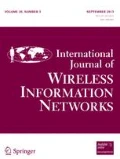Abstract
Aiming at the deficiency of network attack detection, a network attack detection method based on deep neural network is proposed. Firstly, the deep neural network technology is used to study the self-adaptive identification method of the security state, intelligently discriminate the security index of the network, recall comparative learning based on historical data, and establish the classification and identification database of network security. Then, according to the information of security classification and identification database, the corresponding state risk assessment system is mapped. Based on the risk intensity, different levels of early warnings are given. Finally, experimental simulation analysis is carried out to demonstrate the effectiveness of the proposed method. The simulation results show that the proposed method can actively send out early warning before the network is attacked, which obtains a high accuracy of early warning.






References
C. Lethien, J. L. Bideau and T. Brousse, Challenges and prospects of 3D micro-supercapacitors for powering the internet of things, Energy & Environmental Science, Vol. 12, No. 1, pp. 96–115, 2019.
S. Li, L. Li, M. J. Hussain, et al., Sentinel: breaking the bottleneck of energy utilization efficiency in RF-powered devices, IEEE Internet of Things Journal, Vol. 6, No. 1, pp. 705–717, 2019.
L. U. Zhen-Bang and L. H. Zhou, A detection model for multi-stage attacks based on WOWA-FCM, Journal of Sichuan University, Vol. 40, No. 1, pp. 122–126, 2008.
L. Jin, L. Yong, G. Lin, DDoS attack detection based on neural network[C]//International Symposium on Aware Computing, 2010.
D. Ding, Q. L. Han, Y. Xiang, et al., A survey on security control and attack detection for industrial cyber-physical systems, Neurocomputing, Vol. 275, pp. 1674–1683, 2018.
S. Aljawarneh, M. Aldwairi and M. B. Yassein, Anomaly-based intrusion detection system through feature selection analysis and building hybrid efficient model, Journal of Computational Science, Vol. 25, pp. 152–160, 2018.
R. Varatharajan, A. P. Preethi, G. Manogaran, et al., Stealthy attack detection in multi-channel multi-radio wireless networks, Multimedia Tools and Applications, Vol. 77, No. 14, pp. 18503–18526, 2018.
E. Mousavinejad, F. Yang, Q. L. Han, et al., A novel cyber attack detection method in networked control systems, IEEE Transactions on Cybernetics, Vol. 48, No. 11, pp. 3254–3264, 2018.
N. Sultana, N. Chilamkurti, W. Peng, et al., Survey on SDN based network intrusion detection system using machine learning approaches, Peer-to-Peer Networking and Applications, Vol. 12, No. 2, pp. 493–501, 2019.
Y. Yao, B. Xiao, G. Wu, et al., Multi-channel based Sybil attack detection in vehicular ad hoc networks using RSSI, IEEE Transactions on Mobile Computing, Vol. 18, No. 2, pp. 362–375, 2018.
J. Q. James, Y. Hou and V. O. K. Li, Online false data injection attack detection with wavelet transform and deep neural networks, IEEE Transactions on Industrial Informatics, Vol. 14, No. 7, pp. 3271–3280, 2018.
A. H. Hamamoto, L. F. Carvalho, L. D. H. Sampaio, et al., Network anomaly detection system using genetic algorithm and fuzzy logic, Expert Systems with Applications, Vol. 92, pp. 390–402, 2018.
M. Petkovic, I. Basicevic, D. Kukolj, et al., Evaluation of Takagi-Sugeno-Kang fuzzy method in entropy-based detection of DDoS attacks, Computer Science Informaation System, Vol. 15, No. 1, pp. 139–162, 2018.
S. Khan, A. Gani, A. W. A. Wahab, et al., Feature selection of denial-of-service attacks using entropy and granular computing, Arabian Journal for Science and Engineering, Vol. 43, No. 2, pp. 499–508, 2018.
Y. Meidan, M. Bohadana, Y. Mathov, et al., N-BaIoT—network-based detection of IoT botnet attacks using deep autoencoders, IEEE Pervasive Computing, Vol. 17, No. 3, pp. 12–22, 2018.
F. Gu, K. Khoshelham, S. Valaee, et al., Locomotion activity recognition using stacked denoising autoencoders, IEEE Internet of Things Journal, Vol. 5, No. 3, pp. 2085–2093, 2018.
W. Wang, W. Peng, L. Tong, et al., Study on sustainable development of power transmission system under ice disaster based on a new security early warning model, Journal of Cleaner Production, Vol. 228, pp. 175–184, 2019.
Acknowledgement
This work was supported by the National Natural Science Foundation of China (No. 61802116) and the key scientific and technological project of Henan province (No. 192102210113).
Author information
Authors and Affiliations
Corresponding author
Additional information
Publisher's Note
Springer Nature remains neutral with regard to jurisdictional claims in published maps and institutional affiliations.
Rights and permissions
About this article
Cite this article
Li, J., Sun, B. A Network Attack Detection Method Using SDA and Deep Neural Network Based on Internet of Things. Int J Wireless Inf Networks 27, 209–214 (2020). https://doi.org/10.1007/s10776-019-00462-7
Received:
Revised:
Accepted:
Published:
Issue Date:
DOI: https://doi.org/10.1007/s10776-019-00462-7

